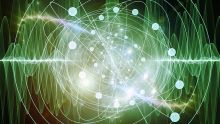First direct measurement of beryllium-7 electron-capture reported in Physical Review C paper

Share this article:
Share this article:
In a recent paper published by Physical Review C (“First direct 7Be electron-capture Q-value measurement toward high-precision searches for neutrino physics beyond the Standard Model”), scientists from Central Michigan University, McGill University, TRIUMF, Colorado School of Mines, and FRIB reported the first direct measurement of the beryllium-7 electron-capture decay value using Penning trap mass spectrometry (PTMS).
The experiment was performed using the Low Energy Beam and Ion Trap (LEBIT) Penning trap at FRIB and utilized the Batch-Mode Ion-Source (BMIS) to deliver the unstable beryllium-7 samples.
The result of the experiment yielded a measurement three times more precise than any previous determination. The scientists noted that the improved precision and accuracy of the beryllium-7 decay value is critical for ongoing experiments that measure the recoiling nucleus in this system as a signature to search for beyond the Standard Model neutrino physics using beryllium-7-doped superconducting sensors.
The experiment extended the capabilities of LEBIT and used the first low-energy beam to be delivered by BMIS at FRIB for PTMS. It also measured the lightest-mass isotope at the time with LEBIT.
This material is based upon work supported by the U.S. Department of Energy Office of Science Office of Nuclear Physics, the National Science Foundation, Michigan State University, the Facility for Rare Isotope Beams, Central Michigan University, and the Gordon and Betty Moore Foundation.
Michigan State University (MSU) operates the Facility for Rare Isotope Beams (FRIB) as a user facility for the U.S. Department of Energy Office of Science (DOE-SC), supporting the mission of the DOE-SC Office of Nuclear Physics. User facility operation is supported by the DOE-SC Office of Nuclear Physics as one of 28 DOE-SC user facilities.
The U.S. Department of Energy Office of Science is the single largest supporter of basic research in the physical sciences in the United States and is working to address some of today’s most pressing challenges. For more information, visit energy.gov/science.

